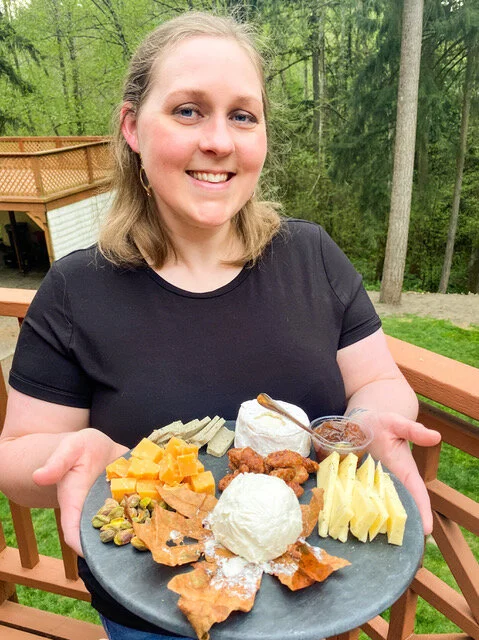How Did Courtney Johnson a German PhD Become a Passionate Cheese Educator?
How does a German Literature scholar make the shift from academia to cheese? Seattle-based cheesemonger and bona fide curd nerd Courtney Johnson has a passion for education. Her early ambitions were focused on earning a PhD in German lit, but a stint at a cheese counter compelled her to shift her focus to, you guessed it, cheese. To that end she has worked intensively in cheese, earning her stripes as an American Cheese Society Certified Cheese Professional. She even took second place in the Cheesemonger Invitational, no simple trivia game. Among other things, competitors must examine a cheese, taste it, and correctly identify it. In 2020 she became executive director of the Washington Cheesemakers’ Association. She blogs at The PhCheese, where readers can develop their cheese knowledge while learning everything from how to pair cheese and beer to how to pronounce those tricky European cheese names.
We caught up with Courtney just as she’s establishing a new business with a friend and fellow cheesemonger Tailor Kowis. Their mobile cheese shop, called Street Cheese, will sell wedges, build platters, and provide cheese education to consumers and cheesemongers alike.
Was cheese a thing in your household growing up, or was it all Kraft Singles and Velveeta?
I ate my fair share of both growing up in a small, rural community in southeastern Arizona, but we also ate a lot of sliced Swiss and Jarlsberg from our Safeway deli counter. My mom is from Germany, and it’s a cultural norm for Germans to eat a meal of bread, cold cuts, cheese, and mustard. We called it Brötchen, even though that word just means “little bread rolls” in German. The first time my mom took me to Germany, I fell in love with Camembert—but even that was the mass-produced, grocery-store variety. I didn’t really encounter artisan cheeses until I moved to the California Bay Area.
You have two degrees in German Studies and a PhD in German Literature. How did you end up making the jump to cheese?
I worked in a grocery during the last two years of writing my doctoral dissertation. I became friends with the cheesemonger and she brought me on as her apprentice. When I started working behind the counter and studying cheese, I knew I’d found the field that would allow me to write and educate people and that would always give me something to learn.
What does your very best day at the cheese counter look like?
There’s nothing better than guiding a customer to an ah-ha moment. In pre-COVID times, that meant leading someone through a tasting where they discovered a new cheese that rendered them speechless. Now, without sampling, it’s seeing a customer get excited about cheese knowledge. I had a man last week who was jazzed we had real Parmigiano Reggiano, because he’d seen videos about it on YouTube and read about it. He was gushing to his wife about how special it was and what the markings on the rind meant. When I told him he could save the rind to flavor a broth and he realized that the rind was just the hard outside of the cheese and not wax, he became so excited he yelled about cheese rinds all the way to the cash register. That’s the kind of interaction that reminds me why I love my job.
What are some of the most common questions you get from your readers and customers? What do you get most tired of having to explain?
I get a lot of reader questions in the vein of, “Is my cheese still good?” Customers ask a lot about whether or not you can eat the rind, or which cheeses are 100-percent grass-fed or certified organic. I do get tired of having to explain that there are plenty of cheeses that are organically produced but not certified organic, and that grass-fed is just a marketing term that often means very little—but that’s all part of the education!
What’s your method for winning over a hesitant customer to an adventurous cheese?
In pre-COVID times, my trick was to sample out adventurous cheeses with dessert pairings: caramels, chocolate, cookies, cake. Customers would take a bite without reading the sign and then find out they’d eaten Limburger and loved it. Now I have to rely on tasting my cheeses often so that I can use the right descriptors. If you use the word “mushroomy” to describe a cheese to someone who hates mushrooms, you just lost them. I ask a lot of questions about what they normally eat and enjoy, and then encourage them to take steps from there. In general, the hardest types of cheeses to get customers to try are goat cheeses.
And the most important question: What’s your desert island cheese?
I have a really hard time picking one, even under duress. If I had to take only one with me to a desert island it would have to be an aged, sheep’s milk cheese. Busti Pecorino Toscano Stagionato is up there on the list, as is Black Head Manech Ossau Iraty. But I have a large purse, so I’m sure there will be multiple cheeses in there when I land on the desert island.


